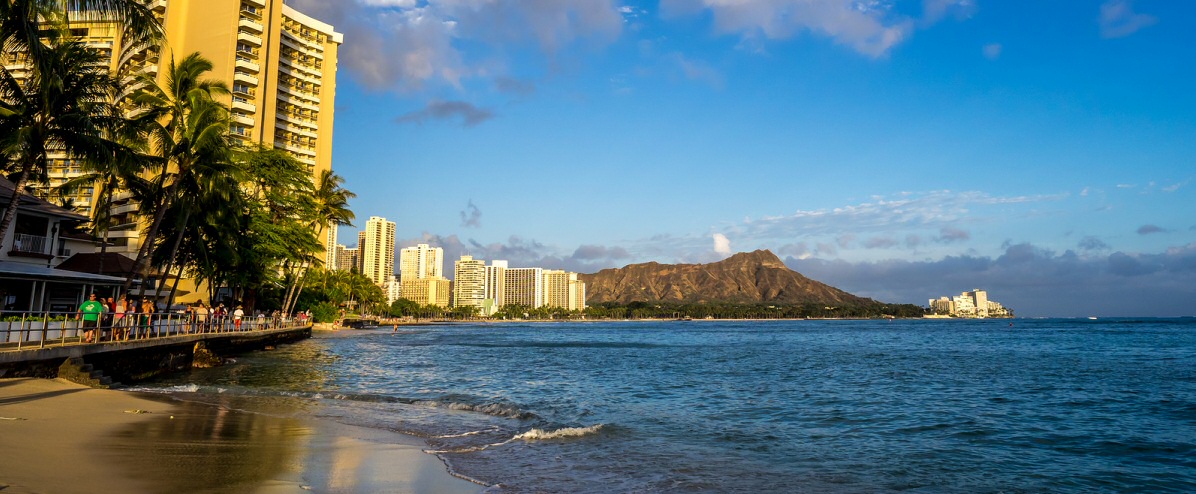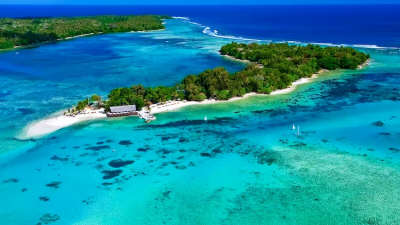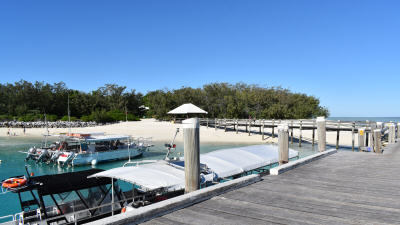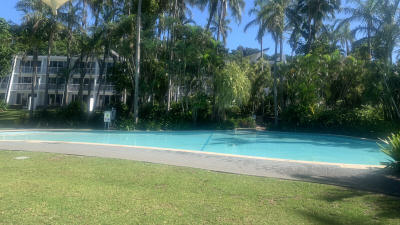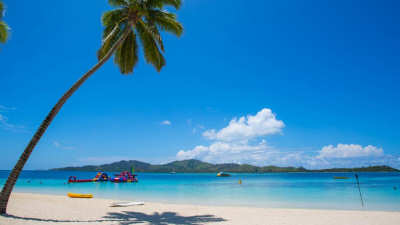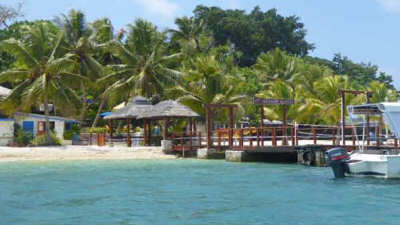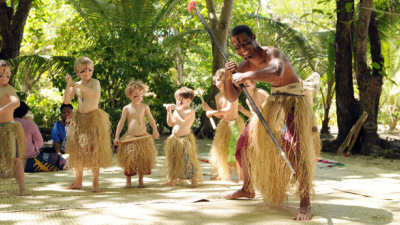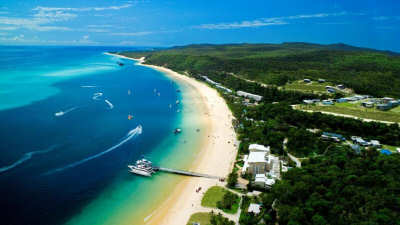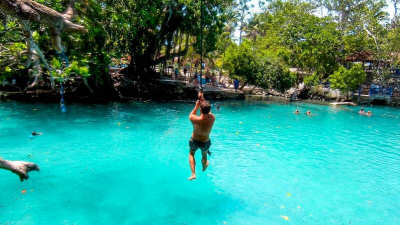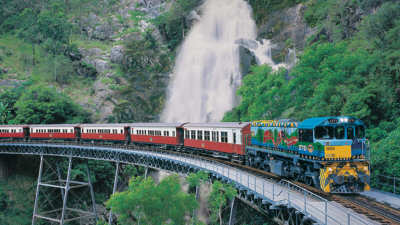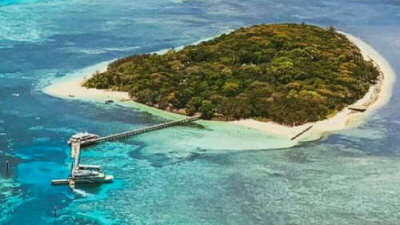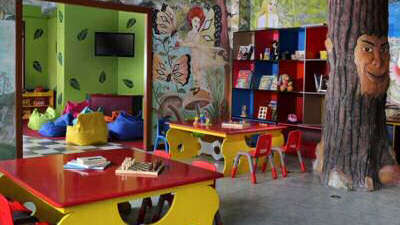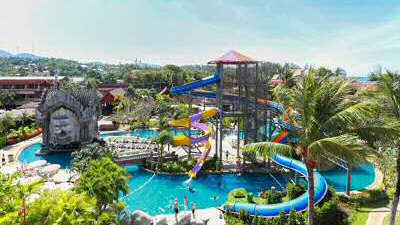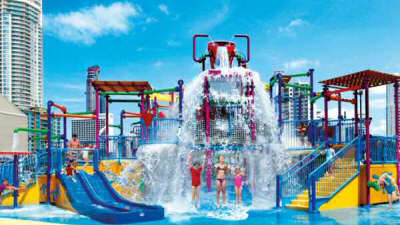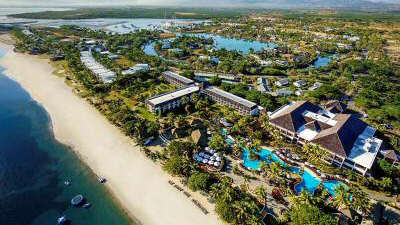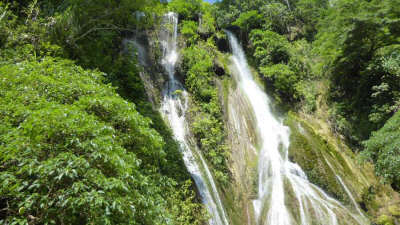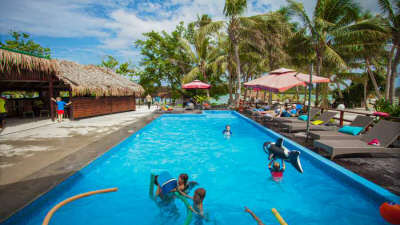Hawaii Travel Guide
Aloha! Welcome to Hawaii, the 50th state of the United States Of America. Hawaii is around 9.5 hours from the east coast of Australia and offers beautiful year round weather, hundreds of beaches, fantastic shopping, and the world famous Waikiki Beach.
Hawaii consists of 6 islands and is located about 9 1/2 hours
flight time from the east coast of Australia. The islands are Kauai, Oahu, Molokai, Lanai, Maui and the Big Island.
Honolulu, the capital of Hawaii, is located on Oahu.
Hawaii's major airport is Honolulu International Airport (HNL) on Oahu, serving as an entry point for most of Hawaii's visitors.
You can catch a flight here to the other Hawaiian islands.
Hawaii's current population is 1.36 million with about 70% of these people living in and around Honolulu.
Samoans, Tongans, Hawaiians, Chinese, Japanese, Maori, Canadians, Tahitians, Vietnamese, Spaniards, Scottish, Irish, Italians
and many other ethnicities combine to form the amazing lifeblood that characterises Hawaii.
The natural wonders of Hawaii, including volcanos and world famous beaches, combined with the cultural and historical attractions of Hawaii
will ensure a great Hawaiian holiday, whatever your interests.
With its warm and gentle trade winds, mild temperatures and sunny skies, Hawaii is an ideal holiday
destination throughout the year. Most of Hawaii has only two seasons - summer, from May to October, and winter, from November to April.

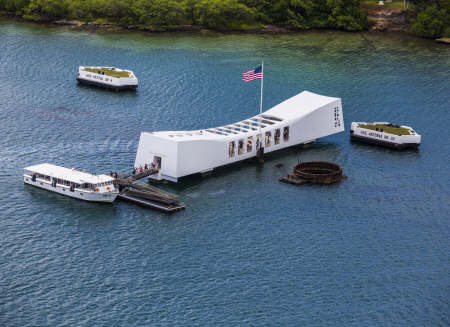
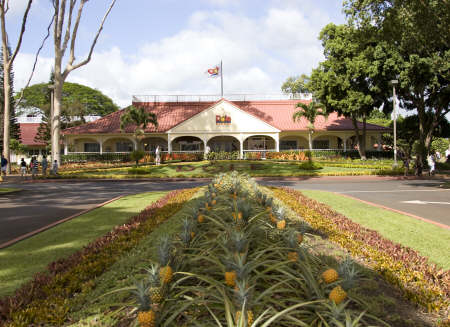
Hawaii is a great place for all kinds of water sports. Try surfing, bodyboarding, stand-up paddle boarding, kayaking, canoeing, scuba diving, parasailing, jet skiing, SNUBA, windsurfing, kitesurfing and fishing. Snorkelling in Hawaii is for everyone. There are plenty of fish to see at most beaches and some areas have coral reef marine reserves. Hanauma Bay is a great place for all the family to try snorkelling. You can hire snorkelling gear on the beach.
The Bus is the main public transport system servicing the whole
island of Oahu. Catch The Bus to Diamond Head, Ala Moana shopping centre, downtown Honolulu or Pearl Harbor.
Most of the bus stops in Waikiki are on both sides of Kuhio Avenue.
Kuhio Avenue runs parallel to the beachfront Kalakaua Avenue, about two short blocks further inland. Waikiki bus stops
are located approximately every two blocks on Kuhio Avenue. For more information
visit www.thebus.org
Waikiki Trolley routes cover almost all tourist attractions and
stops at most major shopping malls on Oahu. For more information
visit
www.waikikitrolley.com
On almost every corner in Waikiki, you'll find an ABC store. You can get almost anything here, from souvenirs to
food and drinks, sunscreen and beach toys. They are so convenient and open 7am-midnight.
The main languages spoken in Hawaii are English and Olelo Hawaii.
Hawaii Facts
Population: Around 1.36 million people on all the Hawaiian Islands
Capital: Honolulu
Location: Located 20 degrees north of the equator and around
4000 kilometres from the US mainland.
Economy: Hawaii's economy includes tourism, agricultural diversification, aquaculture, manganese nodule mining,
and film and television production.
Language: Hawaii has two official languages, English and Olelo Hawaii.
Religion: 34.11% of population are religious - mostly Christian
Climate: The average temperature in the Islands is about 26.6C, dropping to about 23.8C during the winter months with a 5.5C cool-down after the sun disappears.
Summer highs average about 29.4C and winter highs about 25.5C. June and July are the driest months for all islands.
But even in Hawaii's winter months, rain and cloud cover are very intermittent and you should get ample time in the sun.
Currency: US Dollar. 1 cent, 5 cents (nickel), 10 cents
(dime), 25 cents (quarter), 1 dollar, 5 dollars, 10 dollars, 20
dollars, 100 dollars. The dime is smaller than the nickel. All notes
are the same size and colour which can be confusing. Banks are open Monday to Friday 9am-3pm.
Time Zone: Hawaii is one day behind Australia and 4 hours
ahead of Australian Eastern Standard Time. There is no daylight
saving time in Hawaii.
Driving: On Oahu the three freeways H1, H2 and H3 are the
main traffic routes. It is advisable to avoid the freeways from 5:30
to 8:30 am and 3:30 to 6:30pm because of heavy traffic. There are plenty of places to hire cars.
Taxis: Plenty of taxis available. Waikiki is approximately
25 minutes from Honolulu airport which will cost you around $25 - $30 US.
Flying Times To Honolulu: Sydney - 9 hrs 35 min, Brisbane - 11 hrs (via Sydney), Melbourne - 11 hrs.
Passports: All visitors to Hawaii must have a valid passport
with at least 3 months validity beyond the date of departure.
VISAS: No Visa required, but all visitors must have a machine-readable passport and under the Visa Waiver
Programme visitors must register at
ESTA website at least
3 days prior to their trip.
Travelling With Children and Babies: New rules apply for
screening children and babies. Please check the
US TSA site for information on breast milk, baby formulas and
other liquids, and for the screening process for kids.
Health: There are no special requirements or inoculations
required to visit Hawaii. Make sure your travel insurance is
adequate as medical treatment in the US is expensive.
Electricity: The standard US voltage is 110 volts (compared
to Australia's 240 volts). If you are taking any electrical
appliances make sure you get an adapter or two before you leave
(you'd be very lucky to find an aussie power adapter in the US). For
things like hair dryers, charging video players or cameras, handheld
games and laptop computers. Light switches in the US are the
opposite (up for on, down for off).
U.S. Measures: 1 foot = 0.3 metre, 1 mile = 1.6 kilometres,
1 pound = 0.45 kilograms, 1 gallon = 3.784 litres.
Hand Luggage: Restrictions have been placed on the luggage
you can take with you when travelling to the US.
Click here to see what restrictions apply.
Airport
Departing: The airport caters for many tourists so departure procedures run pretty smoothly. You can get flights to the other islands from here - only 20 minutes to Molokai and around 50 mins to Hawaii's Big Island. A variety of shopping and dining options are available at HNL. Hours of operation are based on flight schedules.
Arriving: All major domestic carriers and many international carriers serve Oahu, so you can get here from just about anywhere. Passengers arrive on the second level of the Overseas and Interisland Terminals and the ground level of the Commuter Terminal. Signs will direct you to Baggage Claim, Ground Transportation and intra-terminal transportation. Visitor Information Booths are located in gate areas and baggage claim to assist arriving passengers. There are a number of ways to get to and from Honolulu International Airport. The airport is located 16 kms from Waikiki, and 9.5 kms from downtown Honolulu. HNL is accessible by car, taxi, bus, and shuttle. The taxi fare into Waikiki is approximately US$35, worth catching if you have a family as shuttles are approximately US$9 per person.
Hawaiian Airlines, Qantas, and Jetstar all fly regularly
to Hawaii from the east coast of Australia.
If you arrive early in the morning, be aware you may not be able to check into
your room until the afternoon, so it can be worthwhile to pack a change of clothes at
the top of one of your suitcases so you can still head for the beach. We left our suitcases at the hotel and used
their hospitality area to freshen up and change.
If you are travelling to other islands, allow anywhere from 45-75 minutes to connect for your interisland flight
You can also take the WikiWiki shuttle. Follow an escalator
to get up to the WikiWiki shuttle boarding area. Interisland boarding begins 15-20 minutes prior to flight.
Dining
So many dining options in Waikiki - some of the better family
ones were The Cheesecake Factory, Dennys, Chili's, I-Hop, Bubba Gumps (at Ala Moana shopping centre). Duke's is an iconic Waikiki restaurant
right on the beach. Famous also for their delicious Hula Pie dessert.
The Hard Rock Cafe is also a unique experience, if you haven't been to one before.
The Hawaiian foods which you will come across are pineapple (so fresh here), poi (from taro root), saimin (noodle soup) and poke (raw fish).
Attending a luau is a must-do when in Hawaii. It is a traditional Hawaiian party or feast accompanied by entertainment. It may feature food such as poi,
kalua pig, poke, lomi salmon, opihi, haupia, and beer, and entertainment such as Hawaiian music and hula dancing.
Tipping
Some services that you receive in the US require that you pay a
tip. In particular, restaurant waiters, bus drivers, taxi drivers
and hotel porters. The wages paid to these people are calculated
based on the fact that they will receive a tip for their services.
The accepted tip for restaurant services is 15% (doesn't include
fast food like McDonalds or KFC). The easy way to calculate the
amount you need to tip is to double the sales tax on the docket.
Some restaurants will automatically take the tip out for you,
especially if you are part of a large group (8 or more).
For porters the tip is about $1 per suitcase. A fiver usually keeps them happy.
For public transport tips are not required, but for hired bus trips
(like the transfer from the airport) a dollar per person will
suffice. Service in general is excellent and the fact that the
people providing the service are looking for a tip is probably the
main reason.
Shopping
The Ala Moana centre, located on Ala Moana Boulevard, is one of
the largest open-air shopping centres in the world with over 290 shops
and restaurants. It's about 15 minutes drive from
the centre of Waikiki but can take up to 40 mins by public transport
if you're staying at the eastern end of Waikiki, but there are plenty of buses.
You can catch the Pink Line trolleys there, they run 7 days a week, every 10 minutes.
Teenagers will love Forever 21, Sephora, American Apparel and Victoria's Secret.
Other stores include Macy's, Sears, Victoria's Secret, Guess, Prada and Barnes & Nobles Booksellers.
There is a large foodcourt and also restaurants such as Bubba Gump Shrimp Co. and Romano's
Macaroni Grill.
Waikele Premium Outlets is located in Waipahu, 24 kms west of Honolulu.
The shuttle bus is a great way to get there ($10 return, includes discount booklet).
You can get some great bargains here from famous brands such as Guess, Coach, Levi's and Calvin Klein.
The Vans store sells vans for half the price you pay in Australia. There are some small
kiosks selling food but in the lower area of the centre there is a McDonalds, KFC and a Chili's.
If you love to shop, it's worth the trip.
Pearlridge Shopping Complex is located near the Aloha Stadium and
Arizona Memorial. It is Hawaii’s only two-phased mall connected by a
monorail system.
Aloha Stadium Swap Meet provides bargains, bargains and more
bargains! The popular outdoor bazaar is more than just a shopping
experience. Hundreds of vendors sell island-style products in booths
sprawled across the parking lot of Aloha Stadium, with everything
from souvenirs to plants and T-shirts to collectibles.
Other shopping venues include the International Marketplace in
Waikiki, the Aloha Tower Marketplace and heaps more.
Some things in the US are very cheap compared to what you will pay
in Australia. Most notably clothing and some electrical goods (especially computers,
laptops and TV's). However there are some things to remember. DVD's
may not work in Australia, unless you have a multi zone DVD player,
Playstation games also may not work in Australia. Remember to check
that electrical items can handle 240 volts as well as 110 volts. For
items that use low voltage, adapters can be purchased in Australia.
Pin converters are around A$10 but adapters that convert 240v to
110v are expensive and not practical.
Surfing
Located on Oahu's north shore are the world famous surfing beaches - Waimea Bay and Sunset Beach. Waimea Bay is the home of the Banzai Pipeline (the perfect wave) and the triple crown of surfing during November and December. Makaha is located on the west coast of Oahu and is the home of the International Winter Surfing championships. Other surfing beaches include Kalapaki Beach on Kauai and Maui's south west and west shores. Generally summer waters are very gentle on all beaches but in winter storms in the Pacific can generate huge waves.
Things To Do
There are endless activities available for families in Hawaii. Here is a list of the most popular ones:
Wet n Wild Hawaii
Voted the Kamaaina’s #1 Family Attraction! Wet n Wild Hawaii is 25-acres of safe, clean family fun and excitement. Located 30 minutes west of Waikiki. It’s Hawaii’s only waterpark.
Polynesian Culture Centre
Spread over 42 acres in La'ie on Oahu's north shore - about an hour from Waikiki. It features 7 Pacific Island villages, an IMAX theatre, an evening show, a canoe pageant and a handicraft and arts marketplace. Visitors will get a taste of music, dance, clothing, food, arts and craft and cultural beliefs of the Polynesian people.
Arizona Memorial
During the Japanese attack on Pearl Harbor in 1941 the USS Arizona was sunk along with 1,177 of her crew. The memorial straddles the sunken ship in the middle of the harbor. More than 1.5 million people visit this memorial each year. A 23 minute documentary precedes a boat ride to the memorial. The entire tour takes about one hour 15 minutes. Entry is free.
USS Missouri
The USS Missouri was the site of Japans surrender, bringing an end to World War II. Visitors are able to walk the decks of the Missouri and tour the wardroom and quarters of the battleship as well as see the Surrender Deck where the war ended. There is an admission charge.
Honolulu Zoo
The Honolulu Zoo is located between the slopes of Diamond Head and Waikiki at the corner of Kapahulu Ave. and Kalakaua Blvd. It is open from 9am to 4.30 pm daily. Over 750,000 people visit the Honolulu Zoo annually. It is the largest zoo within a radius of 2,300 miles and unique in that it is the only zoo in the United States originating from a King's grant of royal lands to the people.
Dole Plantation
About an hours drive from Waikiki is the Dole Pineapple Plantation. It includes a 2 mile, 20-minute train tour of the plantation - the Pineapple Express. There's also the 'worlds largest maze' which the kids will enjoy and a garden tour that highlights the wide variety of crops being grown on the North Shore of Oahu.
Healthy Travel
If you plan to go hiking in the backcountry or go swimming in freshwater pools in Hawaii, be advised of the risk of catching leptospirosis. Leptospirosis generally causes flu-like symptoms; in rare cases it can be fatal; the incubation period can be from 2-30 days after exposure. Do not swim in freshwater pools if you have open sores; see a doctor if you develop flu-like symptoms after hiking or swimming.
Hospitals in Hawaii meet U.S. standards for care, and can be found in the urban areas of each island. The hospitals in Honolulu are larger and have the most advanced equipment; the hospitals on the neighbor islands provide general care. There is currently a shortage of specialists on the Neighbor Islands. Depending on where you are and how serious your condition is, be advised that you may need to be medically evacuated to Honolulu for treatment.
The main tourist areas of each island have walk-in urgent care clinics where you can receive non-emergency treatment for whatever ails you. Some clinics even make hotel room calls. Check with the local phone book or your hotel. Be sure to have travel health insurance.
The Language
Hawaii has two official languages, English and Olelo Hawaii. English is spoken universally on the islands. The Hawaiian language, Olelo Hawaii, is spoken largely by Native Hawaiians.
Olelo Hawaii is a Polynesian language. Hawaii's unofficial language is Hawaiian Creole English (HCE). A byproduct of Hawaii's tremendous diversity, HCE, commonly known as "pidgin,"is an other-than-standard English which developed as a means of communication for business transactions.
It's a good idea to learn some of
the Hawaiian language before you arrive. Some of the more common
Hawaiian words and phrases are:
aloha (ah-low-ha) - hello, love, welcome or goodbye.
Aloha Kakahiaka - Good Morning.
Aloha Auina La - Good Afternoon.
E komo mai - welcome.
Mahalo (mah-HAH-loh) - thank you.
kokua (koh-KOO-ah) - help.
Kela 'apopo - tomorrow.
`Olu`olu - please.
Kahakai - Beach.
`Ae - yes
a'ole - no
Money
You'll need cash for things like bus fares, tips etc. Shop around
for the best rate before you get to the airport prior to departure.
Travellers cheques are a good option but cashing them may be a
slight problem. The hotels we've stayed at will only cash up to $100
US per day, which may not be enough to see you through if you plan
to pay everything by cash. Otherwise you'll need to visit one of the
major banks or change at the airport. Best to get travellers cheques in US dollars.
The use of ATM cards is widespread in Hawaii. Depending on the system that your home bank uses,
you can most likely access your personal bank account from abroad.
ATMs get the same wholesale exchange rate as credit cards, but there is often a limit on the
amount of money you can withdraw per day. There is also typically a surcharge of $1-5 per withdrawal.
Debit cards are as convenient as credit cards but withdraw money directly from the holder's bank account.
A debit card can be used wherever its associated credit card company (usually MasterCard or Visa) is accepted.
Debit cards often also function as ATM cards and can be used to withdraw cash from associated banks and
ATMs throughout Hawaii.
The most widely accepted credit cards in the US are Visa, Mastercard, American Express and
Diners Club. The best option would be to pay for most things by card
and only pay cash when necessary.

